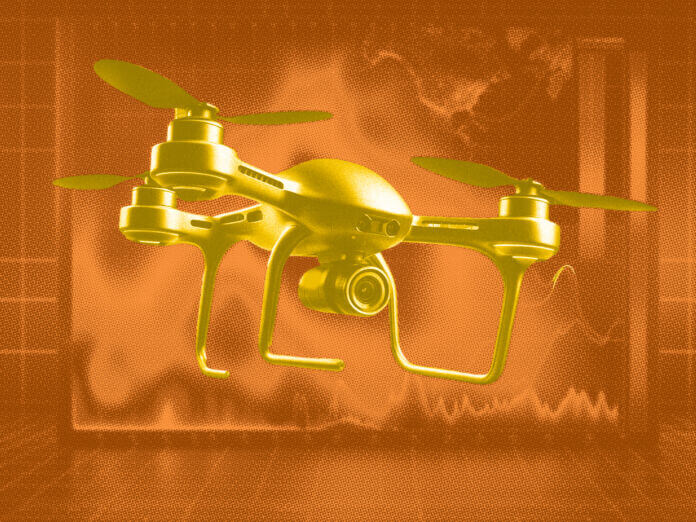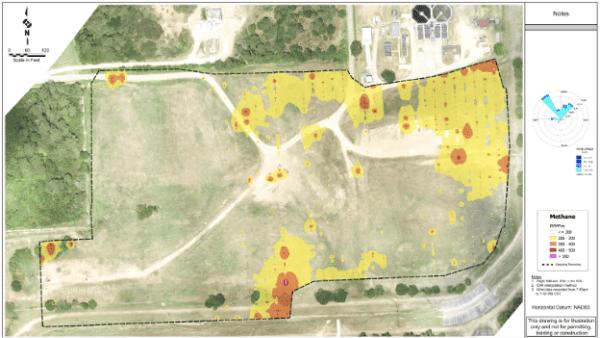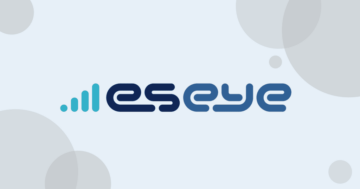
Methane is a common and important greenhouse gas with a great impact on global climate change. With the deepening of environmental protection work, methane (CH4), as the main greenhouse gas, has become an important indicator of environmental protection.
The methane detector has become one of the indispensable tools in the field of environmental protection because of its high sensitivity, real-time performance, and accuracy. Its emergence plays an important role and value in environmental monitoring. The introduction and widespread application of methane detectors have improved the scientific level and technology chain of the current environmental protection industry.
Advantages of Methane Leak Detectors
The UAV laser methane detector is a lightweight UAV-borne device adapted to UAVs. It has high sensitivity, fast detection response, lower cost, and reduces operational risks.
Laser methane gas detectors are based on semiconductor laser absorption spectroscopy technology. They can detect parameters such as methane gas concentration in various environments with high accuracy, fast responses, high reliability, and low operating costs. Compared to fixed gas leak detectors, drones are not only a more cost-effective way to solve the problem but also a more efficient one.
Highly sensitive, laser methane gas detectors can pick up even tiny leaks from a height of 300 meters. The sensor is only sensitive to methane, so there is no possibility of false readings due to the presence of other gases. In addition, drones equipped with methane detectors can penetrate small spaces that workers cannot enter or areas with a high-risk index to ensure the personal safety of workers.
In the realm of UAV-based methane measurement, two primary methodologies prevail. One method is the laser-based sensor (TDLAS – Tunable Diode Laser Absorption Spectroscopy), which gauges CH4 absorption within the air column between the sensor and the ground. The second is the “sniffer” approach, which analyzes methane concentration in air samples taken at or near ground level. While both methods offer accuracy, their data collection processes vary significantly.
When employing a “sniffer” sensor, the unit trails a tube directly on the ground or nearby, actively suctioning air during flight. This approach yields conventional methane concentration readings at designated mission locations, with a sampling rate of x measurements per y timeframe.
In contrast, laser-based sensors execute a meticulous grid pattern, over 20 meters at ground level. The sensor utilizes TDLAS technology for data acquisition.
The Challenges of UAV-Methane Detection
Utilizing UAV-based sensors poses several challenges, with safety being paramount. Both methodologies entail safety risks due to low-altitude UAV flights. However, employing a sniffer sensor introduces additional complexities. These include the risk of the unit snagging objects on the ground and difficulties maintaining altitude accuracy, particularly in areas with fluctuating elevations.
Moreover, sniffer drones cover less ground compared to lidar drones. This can result in logistical hurdles such as battery management and prolonged project completion times. To ensure reliable methane detection data, it’s imperative to minimize the timeframe for data collection to mitigate environmental influences.
Despite concerns, laser-based sensors offer distinct advantages. While pilots must exercise caution to avoid collisions with obstacles such as electric utility infrastructure, the absence of ground contact reduces certain risks. Furthermore, employing a laser altimeter enhances safety by maintaining a consistent altitude above ground level.

Methane leak detector data is georeferenced and seamlessly integrated into GIS systems. Utilizing inverse distance weighted interpolation, hot-spot maps highlighting areas of high methane concentration can be generated, with the option to overlay existing gas system networks from CAD files. Notably, UAV-based methane detection systems offer closer proximity to emission sources, minimizing the impact of wind speeds on data accuracy.
Consideration of wind direction and speed is pivotal during data analysis. The wind vector data is important to avoid “double counting” methane plumes. Accounting for weather patterns helps ensure accurate assessments of methane emissions, facilitating targeted mitigation efforts.
The accompanying methane detection heat maps, while not thermal in nature, effectively pinpoint methane clusters. Furthermore, overlaying this data onto existing gas collection and control systems CAD facilitates the identification of methane leaks. This may empower site operators to implement timely mitigation measures.
In Conclusion
UAV methane detection represents a paradigm shift in environmental surveillance. It presents a game-changing blend of cost-effectiveness, operational efficiency, and unparalleled resolution in methane emission detection.
As this technology matures, its transformative impact on identifying methane sources and orchestrating targeted mitigation strategies will be significant. Ultimately, it will help mitigate the environmental repercussions of methane emissions. With continual innovation and refinement, UAVs may revolutionize methane monitoring. As such, they may emerge as indispensable allies in the global fight against climate change, heralding a future marked by enhanced environmental stewardship and sustainability.
- SEO Powered Content & PR Distribution. Get Amplified Today.
- PlatoData.Network Vertical Generative Ai. Empower Yourself. Access Here.
- PlatoAiStream. Web3 Intelligence. Knowledge Amplified. Access Here.
- PlatoESG. Carbon, CleanTech, Energy, Environment, Solar, Waste Management. Access Here.
- PlatoHealth. Biotech and Clinical Trials Intelligence. Access Here.
- Source: https://www.iotforall.com/using-drones-for-methane-detection-enhancing-environmental-compliance
- :has
- :is
- :not
- $UP
- 1
- 20
- 300
- a
- above
- absence
- accompanying
- Accounting
- accuracy
- accurate
- acquisition
- actively
- adapted
- addition
- Additional
- advantages
- against
- AIR
- also
- an
- analysis
- analyzes
- and
- Application
- approach
- ARE
- areas
- AS
- assessments
- At
- avoid
- based
- battery
- BE
- because
- become
- being
- between
- Blend
- both
- but
- by
- CAD
- CAN
- cannot
- caution
- certain
- chain
- challenges
- change
- Climate
- Climate change
- closer
- collection
- Column
- Common
- compared
- completion
- complexities
- compliance
- concentration
- Concerns
- consistent
- contact
- contrast
- control
- conventional
- Cost
- cost-effective
- Costs
- cover
- Current
- data
- data analysis
- designated
- detect
- Detection
- device
- difficulties
- diode
- direction
- directly
- distance
- distinct
- Drones
- due
- during
- effectively
- efficiency
- efficient
- efforts
- Electric
- emerge
- emergence
- emission
- Emissions
- employing
- empower
- enhanced
- Enhances
- enhancing
- ensure
- Enter
- environmental
- environments
- equipped
- Even
- execute
- Exercise
- existing
- facilitates
- facilitating
- false
- FAST
- field
- fight
- Files
- fixed
- flight
- Flights
- For
- from
- Furthermore
- future
- GAS
- generated
- Global
- great
- greenhouse gas
- Grid
- Ground
- Have
- height
- help
- helps
- heralding
- High
- high-risk
- highlighting
- However
- HTTPS
- Hurdles
- Identification
- identifying
- Impact
- imperative
- implement
- important
- improved
- in
- include
- index
- Indicator
- indispensable
- industry
- Infrastructure
- Innovation
- integrated
- interpolation
- into
- Introduces
- Introduction
- inverse
- IT
- ITS
- jpg
- laser
- leak
- Leaks
- less
- Level
- lidar
- lightweight
- locations
- Low
- lower
- Main
- maintaining
- management
- map
- Maps
- marked
- matures
- max-width
- May..
- measurement
- measurements
- measures
- methane
- methane emissions
- Methane Leak
- method
- methodologies
- methods
- meticulous
- minimize
- minimizing
- Mission
- Mitigate
- mitigation
- monitoring
- more
- more efficient
- must
- Nature
- Near
- networks
- no
- notably
- objects
- obstacles
- of
- offer
- on
- ONE
- only
- onto
- operating
- operational
- operators
- Option
- or
- Other
- over
- paradigm
- parameters
- Paramount
- particularly
- Pattern
- patterns
- per
- performance
- personal
- pick
- Pilots
- pivotal
- plato
- Plato Data Intelligence
- PlatoData
- plays
- poses
- possibility
- presence
- presents
- primary
- Problem
- processes
- project
- protection
- Rate
- real-time
- realm
- reduces
- reliability
- reliable
- repercussions
- represents
- Resolution
- response
- responses
- result
- revolutionize
- Risk
- risks
- Role
- Safety
- scientific
- seamlessly
- Second
- semiconductor
- sensitive
- Sensitivity
- sensors
- several
- shift
- significant
- significantly
- site
- small
- So
- SOLVE
- Sources
- spaces
- Spectroscopy
- speed
- speeds
- Stewardship
- strategies
- such
- surveillance
- Sustainability
- system
- Systems
- taken
- targeted
- Technology
- that
- The
- their
- There.
- thermal
- These
- they
- this
- timeframe
- timely
- times
- tiny
- to
- tools
- transformative
- two
- UAV
- Ultimately
- unit
- unparalleled
- using
- utility
- utilizes
- Utilizing
- value
- various
- vary
- vector
- Way..
- Weather
- weather patterns
- which
- while
- widespread
- will
- wind
- with
- within
- Work
- workers
- X
- yields
- zephyrnet









